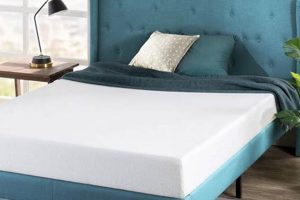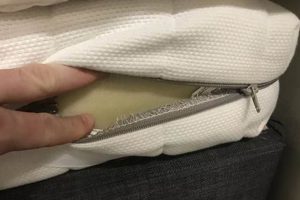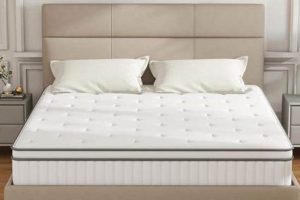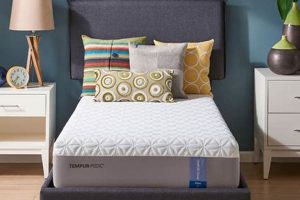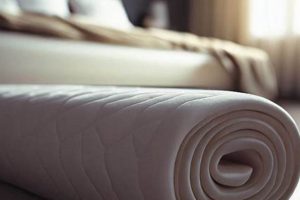Whether one should invert or rotate a bed comprised of visco-elastic polyurethane foam is a common inquiry. This stems from a desire to maximize the lifespan and maintain the comfort level of the sleep surface. The density and conforming nature of the material can lead to impressions over time, particularly in areas where weight is concentrated.
The primary rationale for addressing this practice involves even distribution of wear. By periodically altering the orientation of the sleeping surface, one can potentially mitigate the formation of lasting indentations. Historically, the practice of flipping innerspring mattresses was commonplace to address coil fatigue and uneven wear. The evolution of mattress technology, including the incorporation of specific foam layers and designs, necessitates a reevaluation of these conventional approaches.
The following sections will delve into the specifics of proper care for these types of beds, examining the nuances of rotation versus inversion, addressing the impact of mattress construction, and offering guidelines for optimal longevity.
Guidelines for Memory Foam Mattress Care
Optimizing the longevity and performance of a visco-elastic polyurethane foam bed requires adherence to specific maintenance practices. The following guidelines provide insights into proper care techniques.
Tip 1: Determine Mattress Construction: Before implementing any rotation or inversion strategy, identify the mattress construction. Some designs feature distinct layers optimized for specific positions, rendering flipping inadvisable.
Tip 2: Prioritize Rotation: In most instances, rotationturning the mattress 180 degreesis the recommended practice. This redistributes weight and minimizes localized wear patterns.
Tip 3: Consider Weight Distribution: Evaluate sleeping habits. If one individual consistently occupies a specific area of the bed, more frequent rotation may be beneficial.
Tip 4: Consult Manufacturer Guidelines: Always adhere to the manufacturer’s recommendations. The warranty may be voided by improper care practices.
Tip 5: Utilize a Protective Mattress Cover: A high-quality mattress protector safeguards against spills, stains, and dust mites, contributing to long-term hygiene and structural integrity.
Tip 6: Ensure Proper Support: The foundation or bed frame must provide adequate support across the entire mattress surface. Sagging or uneven support can accelerate wear and compromise comfort.
Tip 7: Periodically Inspect for Indentations: Regularly examine the surface for persistent indentations. Early detection allows for proactive adjustments to rotation frequency or support.
Adherence to these tips promotes even wear, preserves comfort, and extends the lifespan of the sleep surface, thus maximizing its value.
The concluding section will summarize the key considerations for maintaining the optimal condition of a memory foam mattress.
1. Rotation Frequency
Rotation frequency directly impacts the longevity and uniform wear of memory foam mattresses. The visco-elastic nature of the material renders it susceptible to compression and impression formation under consistent pressure. Absent periodic rotation, localized areas bearing the majority of weight will exhibit accelerated degradation compared to less utilized sections. This uneven wear diminishes support and comfort over time.
Consider a scenario where a single individual consistently sleeps on one side of the mattress. Without regular rotation, that side will compress more rapidly, resulting in a noticeable sag. By rotating the mattress 180 degrees on a scheduled basis (e.g., every three to six months), weight distribution is normalized. This allows previously compressed foam cells to recover, promoting more uniform wear across the entire sleep surface. The specific frequency depends on factors such as sleeper weight, sleeping position, and mattress density.
In summary, establishing an appropriate rotation frequency represents a key maintenance practice for visco-elastic polyurethane foam beds. It directly mitigates uneven wear, extends the useable lifespan, and preserves the original support characteristics. While specific intervals vary based on individual circumstances, proactive rotation significantly contributes to sustained comfort and overall mattress value.
2. Mattress Construction
Mattress construction directly dictates the appropriateness of inverting or rotating the sleep surface. Traditional innerspring mattresses often benefited from flipping, owing to their symmetrical design. However, visco-elastic polyurethane foam beds often incorporate layered designs with varying densities and specific comfort features. Inversion can disrupt the intended support system and compromise the intended comfort profile.
Consider a mattress featuring a distinct comfort layer, transition layer, and support core. The comfort layer, typically a softer, less dense foam, is designed to provide immediate pressure relief. The support core, usually a denser, more resilient foam, provides foundational support and prevents sagging. Inverting this construction would place the denser support core in direct contact with the sleeper, negating the pressure-relieving benefits of the comfort layer. Hybrid mattresses, incorporating both coils and foam layers, present similar considerations. The coil system may be designed for specific weight distribution, and inverting the mattress can negatively impact its support characteristics.
Therefore, understanding the constituent layers and their intended function is crucial before undertaking any rotation or inversion strategy. The manufacturer’s specifications typically provide detailed information regarding the mattress’s construction and recommended care practices. Failure to adhere to these guidelines can not only diminish comfort but also potentially void the warranty. Consequently, a careful examination of the bed’s assembly is paramount to informed maintenance.
3. Weight Distribution
Weight distribution exerts a significant influence on the lifespan and performance of visco-elastic polyurethane foam mattresses. The material’s inherent conforming properties render it susceptible to localized compression under consistent pressure. An uneven weight distribution pattern, whether due to individual sleeping habits, shared occupancy, or variations in body mass, accelerates wear in concentrated areas. This leads to indentation formation and a degradation of support, ultimately diminishing overall comfort.
The practic
e of rotating a memory foam mattress directly addresses the issue of uneven weight distribution. By periodically altering the orientation of the sleep surface, the weight-bearing zones are shifted, allowing compressed foam cells to recover and preventing the development of permanent impressions. For example, an individual who consistently sleeps on one side of the mattress will create a localized area of compression. Regular rotation equalizes this compression, extending the mattress’s lifespan. Similarly, a couple with disparate body weights can mitigate differential compression by implementing a consistent rotation schedule. Failure to address weight distribution through rotation results in premature sagging and a compromised sleep experience.
In summary, weight distribution is a critical factor in memory foam mattress longevity. Implementing a regular rotation schedule is a proactive measure to counteract the effects of concentrated pressure. This practice promotes even wear, preserves support characteristics, and ultimately extends the useful life of the mattress, ensuring a more comfortable and supportive sleep surface over time.
4. Manufacturer's Guidelines
The guidelines provided by the manufacturer are paramount to ensuring the longevity and optimal performance of any memory foam mattress. These directives outline the recommended care practices, specifically addressing inquiries about turning or rotating the mattress and dictating the boundaries of warranty coverage.
- Rotation Recommendations
Manufacturers often specify whether rotation is recommended and, if so, the optimal frequency. Some mattresses may be designed for 180-degree rotation every three to six months, while others may discourage any form of flipping or rotation due to layered construction. Disregarding these instructions can lead to uneven wear and potential damage.
- Construction-Specific Instructions
Visco-elastic polyurethane foam mattresses exhibit diverse construction techniques, including single-sided designs and multi-layered configurations. Manufacturer guidelines clarify whether the mattress is intended for one-sided use only, precluding the possibility of flipping. Deviation from these instructions can compromise the intended support and comfort characteristics.
- Warranty Implications
Non-compliance with the manufacturer’s care instructions can void the warranty. For instance, attempting to invert a mattress designed solely for one-sided use may be considered misuse, nullifying any recourse for defects or premature wear. Adhering to the recommended rotation or non-rotation practices is crucial for maintaining warranty eligibility.
- Foundation Requirements
Manufacturer’s guidelines frequently stipulate the appropriate type of foundation or bed frame to ensure adequate support. Using an incompatible foundation can compromise the mattress’s structural integrity and accelerate wear. This is closely linked to any rotation or turning advice, as proper support is essential to prevent sagging, regardless of rotation frequency.
The manufacturer’s guidelines serve as the definitive resource for proper maintenance of memory foam mattresses. These instructions offer insights into rotation practices, construction-specific considerations, warranty implications, and foundation requirements. Compliance with these directives is paramount for preserving mattress integrity, maximizing lifespan, and upholding warranty provisions.
5. Protective Cover
The employment of a protective cover significantly influences the efficacy of rotation practices for visco-elastic polyurethane foam mattresses. While rotation aims to distribute wear and prolong mattress lifespan, a protective cover acts as a primary barrier against external factors that accelerate degradation. Spills, stains, and dust mite infestations can compromise the foam’s structural integrity, rendering rotation less effective in mitigating damage. A high-quality, waterproof protective cover safeguards the mattress from these elements, ensuring that rotation addresses compression rather than irreversible damage. For instance, a memory foam mattress subjected to frequent spills without protection will experience accelerated foam breakdown, negating the benefits of rotation.
Furthermore, a protective cover maintains the hygiene of the sleep surface. Dust mites and allergens can accumulate within the foam, impacting sleep quality and overall health. A hypoallergenic protective cover creates a barrier, preventing these irritants from penetrating the mattress. When rotating a mattress, the protective cover minimizes the transfer of accumulated dust and allergens, promoting a cleaner and healthier sleep environment. This synergistic effect enhances the value of rotation as a maintenance practice. Consider a scenario where rotation occurs without a cover; accumulated dust and allergens on the underside are transferred to the sleep surface, potentially exacerbating allergies.
In summary, the protective cover serves as a crucial complement to rotation practices. It addresses factors beyond compression, safeguarding against spills, stains, dust mites, and allergens. By maintaining the cleanliness and structural integrity of the foam, the protective cover maximizes the effectiveness of rotation as a strategy for prolonging mattress lifespan and preserving comfort. The concurrent use of both a high-quality cover and a consistent rotation schedule is essential for comprehensive mattress care.
6. Foundation Support
Foundation support exerts a direct and significant influence on the appropriateness and effectiveness of turning or rotating a memory foam mattress. An inadequate or incompatible foundation compromises the mattress’s structural integrity, negating the intended benefits of distributing wear through rotation. When a mattress lacks sufficient support, localized areas experience increased stress, accelerating compression and indentation formation, regardless of rotation efforts. The uneven distribution of weight caused by poor foundation support undermines the goal of balanced wear achieved through rotation.
Consider a memory foam mattress placed on a slatted frame with excessively wide gaps. The areas of the mattress resting between the slats will sag over time, creating uneven support. Rotating the mattress in this scenario simply shifts the sagging areas, failing to address the underlying problem. A more appropriate foundation, such as a solid platform or closely spaced slats, provides uniform support, enabling rotation to effectively distribute wear across the entire surface. Similarly, using a box spring designed for innerspring mattresses with a memory foam mattress can result in inadequate support and premature sagging. The foundation must be compatible with the specific construction and weight distribution characteristics of the memory foam mattress.
In summary, proper foundation support is a prerequisite for successfully rotating a memory foam mattress. An inadequate foundation undermines the intended benefits of rotation by creating uneven weight distribution and accelerating localized co
mpression. Ensuring compatibility between the mattress and foundation is crucial for preserving structural integrity, maximizing lifespan, and optimizing the effectiveness of rotation as a maintenance practice. Therefore, careful consideration of foundation support is an integral component of comprehensive memory foam mattress care.
7. Indentation Monitoring
The systematic observation and assessment of surface depressions on a visco-elastic polyurethane foam bed, termed indentation monitoring, holds a pivotal role in determining the necessity and efficacy of rotation practices. This proactive approach allows for the early detection of uneven wear, guiding informed decisions regarding mattress maintenance and optimizing its lifespan.
- Frequency of Inspection
Regularly scheduled inspections, conducted at intervals ranging from monthly to quarterly, enable the identification of developing indentations before they become pronounced and irreversible. Consistent monitoring facilitates timely intervention, such as adjusting the rotation schedule or addressing underlying support issues. An example involves a couple noticing a slight depression on one side of the mattress during a monthly inspection, prompting them to rotate the mattress sooner than initially planned, preventing further indentation.
- Techniques for Assessment
Visual inspection, tactile examination, and the use of a straight edge are all viable techniques for assessing indentation depth and extent. Visual assessment involves observing the surface for obvious depressions. Tactile examination entails running one’s hand across the surface to detect subtle variations in height. A straight edge, placed across the mattress, allows for precise measurement of indentation depth. For instance, employing a straight edge reveals a 1-inch depression in the area where an individual consistently sleeps, indicating a need for more frequent rotation.
- Correlation with Rotation Schedule
The data gathered from indentation monitoring informs adjustments to the established rotation schedule. If indentations develop rapidly despite regular rotation, the frequency should be increased. Conversely, if the mattress exhibits minimal indentation, the rotation interval can be extended. An example of this is a mattress that shows minimal indentation after six months of rotation. The rotation schedule can safely be updated to every nine months.
- Identification of Underlying Issues
Persistent indentations, even with regular rotation, may indicate underlying problems, such as inadequate foundation support or uneven weight distribution. Indentation monitoring serves as a diagnostic tool, prompting investigation into these contributing factors. In one case, a mattress that showed significant indentations despite rotation prompted the owners to replace the foundation which fixed the issue.
Indentation monitoring, therefore, acts as a feedback mechanism in the overall maintenance of a memory foam mattress. The insights gained from these assessments directly inform rotation practices, ensuring that the bed’s comfort and support characteristics are preserved for an extended period. The integration of indentation monitoring with a well-defined rotation schedule represents a comprehensive approach to mattress care.
Frequently Asked Questions About Memory Foam Mattress Maintenance
This section addresses common inquiries regarding the proper care and maintenance of visco-elastic polyurethane foam mattresses, specifically focusing on rotation and inversion practices.
Question 1: Is it advisable to invert a memory foam mattress?
Inverting a mattress may not be advisable due to the construction of the bed. Designs with specialized comfort layers on one side may lose their intended support and comfort profile if inverted. Refer to the manufacturers guidelines.
Question 2: How frequently should a memory foam mattress be rotated?
The frequency of rotation depends on several factors, including sleeper weight, number of occupants, and mattress density. As a general guideline, rotating the mattress 180 degrees every three to six months is recommended. Monitor the surface for indentations.
Question 3: What are the risks of not rotating a memory foam mattress?
Failure to rotate the mattress can lead to localized compression and the development of permanent indentations in areas that bear the most weight. This results in uneven support and diminished comfort.
Question 4: Can rotating a mattress void the warranty?
Rotating the mattress will generally not void the warranty, provided it aligns with the manufacturer’s instructions. However, improper care practices, such as inverting a single-sided mattress, may void the warranty. Review the warranty terms and conditions.
Question 5: How can uneven wear be detected in a memory foam mattress?
Uneven wear can be detected through visual inspection, tactile examination, and the use of a straight edge. Look for visible indentations, feel for variations in surface height, and use a straight edge to measure indentation depth.
Question 6: Does the type of bed frame impact the need for rotation?
The type of bed frame significantly impacts the need for rotation. Inadequate support accelerates localized compression. Ensure the bed frame provides uniform support across the entire mattress surface.
Properly maintaining a memory foam mattress involves understanding its construction, adhering to manufacturer’s guidelines, and proactively addressing potential wear. Regular rotation, when appropriate, is a key component of this maintenance.
The subsequent section will summarize the key factors discussed in this article, offering a concise guide to memory foam mattress care.
Can You Turn a Memory Foam Mattress? Key Considerations.
The preceding exploration of “can you turn a memory foam mattress” illuminates the multifaceted nature of its care. Factors encompassing mattress construction, weight distribution, foundation support, and manufacturer directives collectively determine the appropriateness and frequency of rotation. A proactive approach, characterized by regular inspection and adherence to established guidelines, is paramount to preserving the structural integrity and comfort characteristics of the sleep surface.
Ultimately, the decision to invert or rotate a memory foam mattress must be informed by a comprehensive understanding of its specific design and the potential implications for its longevity. Prioritizing informed decision-making ensures the continued provision of optimal sleep support and a maximized return on investment.


